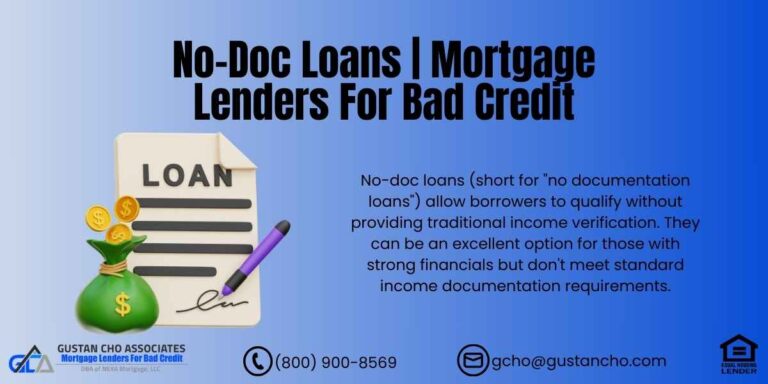Mortgage After Bankruptcy Guidelines
This guide covers mortgage after bankruptcy guidelines. We will discuss the mandatory waiting period to qualify for a government-backed loan and conventional mortgage after bankruptcy. Homebuyers and homeowners can qualify for a home purchase mortgage loan or a home refinance mortgage after bankruptcy. Marga Jurilla, a senior mortgage loan originator and executive assistant to Gustan Cho at Mortgage Lenders for Bad Credit, says the following about getting approved for a mortgage after bankruptcy:
Both HUD and Fannie Mae recently announced new mortgage lending guidelines to qualify mortgage after bankruptcy recently. In general, FHA guidelines for a mortgage after bankruptcy are 2 years from the discharge date of the bankruptcy.
This is the same guideline as prior years on the waiting period to qualify for a mortgage after bankruptcy. Fannie Mae’s lending guidelines for a mortgage after Chapter 7 bankruptcy are 4 years from the discharge date. In the following paragraphs, we will cover mortgage after bankruptcy on FHA, VA, USDA, and conventional loans.
Switching jobs during a mortgage process can intersect with your earlier tradeline question. Still, I’ll focus on that since you’ve asked about mortgage guidelines post-bankruptcy. Here’s a breakdown of the current guidelines for FHA, VA, USDA, Non-QM, and Conventional loans after bankruptcy, tailored to help you advise your client effectively. These are based on standard lending practices as of March 27, 2025, with no strict cutoff since my knowledge is continuously updated.
FHA Loans
Chapter 7 Bankruptcy
- You’re eligible 2 years after the discharge date (not the filing date).
- If there are extenuating circumstances.
- Like a job loss or medical emergency beyond your control—you might qualify after 1 year with strong documentation (e.g., medical records, layoff notice) and proof of re-established credit (timely payments on new accounts).
Chapter 13 Bankruptcy
- With court approval, you can apply after 1 year of on-time payments in your repayment plan.
- No waiting period is required post-discharge, so you could apply the day after discharge if you meet other FHA criteria (e.g., 580+ credit score for 3.5% down or 500-579 for 10% down).
Key Requirements
- Rebuild credit post-bankruptcy (no late payments), have a debt-to-income (DTI) ratio typically under 43%, and the home must be your primary residence. FHA is lenient, making it a go-to for post-bankruptcy borrowers.
Qualify for a Mortgage After Bankruptcy – Start Fresh Today!
Apply Now And Get recommendations From Loan Experts
VA Loans
Chapter 7 Bankruptcy
- A 2-year wait from the discharge date is standard.
- Lenders want a clean credit history during that time—no new delinquencies.
Chapter 13 Bankruptcy
- With trustee approval, you can apply after 1 year of on-time repayment plan payments.
- There is no waiting period post-discharge, assuming you qualify otherwise (e.g., Certificate of Eligibility, 620+ credit score with most lenders).
Key Requirements
- VA loans are flexible for veterans and active-duty members, with no down payment required.
- Lenders focus on residual income and a stable post-bankruptcy financial picture.
- If a prior VA loan was discharged in bankruptcy, entitlement might be tied up, potentially requiring a down payment.
USDA Loans
Chapter 7 Bankruptcy
- A 3-year wait from discharge is typical.
- Exceptions exist for extenuating circumstances (e.g., temporary income loss), potentially dropping it to 1 year with USDA approval via automated underwriting.
Chapter 13 Bankruptcy
- Eligible after 1 year of on-time payments in the repayment plan.
- No court approval is explicitly required if payments are current.
- Post-discharge, no additional wait if credit is rebuilt (640+ score often preferred).
Key Requirements
- Must buy in a USDA-eligible rural area, meet income limits (low-to-moderate), and show stable finances.
- There is no down payment, but credit hiccups post-bankruptcy can complicate approval.
Non-QM Loans
Chapter 7 Bankruptcy
- There is no mandatory waiting period—some lenders approve immediately after discharge if you’ve got a big down payment (20-40%) and a strong income.
- These are niche products, so terms vary wildly.
Chapter 13 Bankruptcy
- Possible during the repayment plan or right after discharge, with no fixed wait.
- Lenders might look at your payment history and equity/down payment more than time elapsed.
Key Requirements
- Non-QM (non-qualified mortgage) loans dodge standard guidelines, focusing on alternative qualifiers like bank statements, assets, or rental income.
- Expect higher interest rates (7-10%+), hefty down payments, and fees. Still, they’re a lifeline if your client needs a mortgage ASAP post-bankruptcy.
Conventional Loans
Chapter 7 Bankruptcy
- Per Fannie Mae/Freddie Mac guidelines, a 4-year wait from discharge is standard.
- Extenuating circumstances (e.g., death of a primary earner) can reduce it to 2 years with solid proof and a rebuilt credit profile (620-640+ score).
Chapter 13 Bankruptcy
- 2 years from discharge or 4 years from dismissal (if you didn’t complete the plan).
- Extenuating circumstances can trim the dismissal wait to 2 years.
- No approval during an active repayment plan—bankruptcy must be fully resolved.
Key Requirements
- Stricter than government-backed options. Needs a 620+ credit score, 3-20% down payment (depending on PMI), and DTI under 45-50%.
- Multiple bankruptcies in the last 7 years bump the wait to 5 years (or 3 with extenuating circumstances).
Practical Tips for Your Client
Credit Rebuilding
- Post-bankruptcy, they’ll need 12-24 months of flawless payment history on new credit (e.g., secured cards, auto loans).
- Check their credit report for errors via AnnualCreditReport.com—discharged debts lingering can drag scores down.
Timing the Application
- FHA or VA might be the fastest if they’re 1-2 years from Chapter 13 or 2 years from Chapter 7.
- Non-QM is the nuclear option if they can’t wait but have cash.
- Conventional is a long game unless extenuating circumstances apply.
Lender Overlays
- Some banks impose extra rules (e.g., waiting 2 years post-Chapter 13 discharge for FHA, despite no official requirement).
- Shop lenders—smaller ones or those specializing in post-bankruptcy loans (e.g., Carrington Mortgage)—might be more flexible.
Documentation
- Gather discharge papers, court approvals (for Chapter 13), and a letter explaining the bankruptcy cause.
- Lenders love a story of redemption backed by evidence.
Tie-In to Tradelines
- Suppose your client’s using tradelines to boost their credit for a mortgage post-bankruptcy, timing matters.
- Tradelines (authorized user accounts) can juice their score fast, but lenders often filter out “piggybacked” credit unless it’s seasoned (6-12 months).
- FHA and VA are less picky about this than Conventional, so pairing a tradeline with a government-backed loan might align with their timeline.
- Ensure the tradeline reports to at least two bureaus and doesn’t flag it as suspicious during underwriting.
qualify for a mortgage and move forward to secure your new home, even after bankruptcy
Apply Now And Get recommendations From Loan Experts
UPDATED Fannie Mae And Freddie Mac Conventional Mortgage After Bankruptcy Guidelines
However, Fannie Mae came up with new Fannie Mae Guidelines: if a homeowner has a mortgage included in Chapter 7 bankruptcy. Then the waiting period for both the mortgage and bankruptcy starts four years from the bankruptcy discharge date. The housing event needs to be finalized. Homeowners cannot have the mortgage included in bankruptcy reaffirmed. Dale Elenteny, a senior mortgage loan originator at Mortgage Lenders for Bad Credit, says the following about getting a conventional mortgage after bankruptcy:
Before this new Fannie Mae guideline, for borrowers with a mortgage or foreclosure as part of bankruptcy, the waiting period did not start until the recorded date of the housing event. The waiting period was four years from the discharge date of the bankruptcy. 7 years from the recorded date of the foreclosure, which is reflected on the county records.
Waiting periods for a mortgage after a deed in lieu of foreclosure and/or short sale under Fannie Mae guidelines is 4 years. HUD treats short sales and deeds in lieu of foreclosure the same as a regular foreclosure, unlike Fannie Mae and Freddie Mac. Mortgage underwriters are very cautious when underwriting borrowers with a prior bankruptcy and/or housing event.
What Do Underwriters Look For in Borrowers With Prior Bankruptcy?
FHA and conventional guidelines on mortgage after bankruptcy and qualification requirements of borrowers:
- The first thing mortgage underwriters will look at when reviewing borrowers with prior bankruptcies is to confirm that the bankruptcy was discharged
- This means that the bankruptcy is totally complete and fully discharged
- Mortgage underwriters will also look to borrowers who have met the mandatory waiting period after bankruptcy
- 2 years from the discharge date for FHA Loans and 4 years for conventional loans
- The filing date of bankruptcy is different than the discharge date of a bankruptcy
It normally takes 90 days or more to have a Chapter 7 bankruptcy discharged from the original filing date of the bankruptcy.
FHA And Conventional Guidelines On Mortgage After Bankruptcy: Late Payments After Bankruptcy And Foreclosure

Under FHA and conventional guidelines on mortgage after bankruptcy, there is no written rule that late payments after bankruptcy and foreclosure are deal killers. However, late payments after bankruptcy and/or foreclosure are not viewed favorably and may affect the findings you will get from the Automated Underwriting System.
Here are other factors that play into the equation when it comes to late payments after bankruptcy and foreclosure:
- Another important factor that mortgage underwriters look for is late payments after a bankruptcy discharge.
- Most mortgage underwriters do not like late payments after a bankruptcy and/or housing event
- It does not matter how old a bankruptcy discharge is
- One or two late payments after a bankruptcy may not be a deal killer with a good letter of explanation
- However, there are lenders that will flatly deny a mortgage application if they have had any late payments after bankruptcy
- If the lender that is telling borrowers do not qualify due to late payments after bankruptcy, please contact me at 800-900-8569 or text us for faster response
- As long as borrowers get an approve/eligible per AUS, Mortgage Lenders for Bad Credit can get mortgage approval
Mortgage Lenders for Bad Credit is a national five-star mortgage company with no mortgage lender overlays on government and conventional loans.
Re-established Credit After Bankruptcy And Foreclosure
Another important factor that mortgage underwriters look at is re-established credit after bankruptcy.
- Re-established credit is extremely important
- Many folks who filed bankruptcy and had their bankruptcy discharged have a hard time getting new credit
- Often times consumers do not even try to get new credit and just purchase their goods with cash
- Unfortunately, this practice is not good when it comes to qualifying for a mortgage after bankruptcy
- Folks who had their bankruptcies just recently discharged should immediately get three to five secured credit cards with at least a $500 credit limit
- Secured credit cards are the best tools to use in re-establishing one’s credit
Each secured credit card should boost a consumer’s credit report by at least 20 to 30 points, and the longer the secured credit card ages, the higher the consumer’s credit scores will be.
Bankruptcy On Credit Report
All derogatory credit items will remain on the credit reports for a period of 7 years from the date of the last activity.
- However, a bankruptcy will remain on the credit report for a period of 10 years from the discharge date of bankruptcy
- Once someone files bankruptcy, they will see their credit scores drop by 200 points
- However, bankruptcy is like a major hangover
- Even though the bankruptcy remains on the credit report for a period of 10 years, as time passes, the bankruptcy will have less and less impact on credit scores
Adding new positive credit and being on time with new credit will offset the negative impact the bankruptcy has on credit score.
Don’t let bankruptcy stop your homeownership dreams—let’s make it happen today!
Apply Now And Get recommendations From Loan Experts







